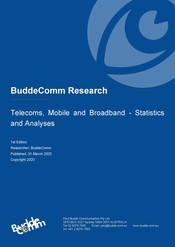2017 Global Digital and Mobile Media - Video Streaming, Smart TV and Entertainment Industries

Last updated: 31 May 2017 Update History
Report Status: Archived
Report Pages: 75
Lead Analyst: Kylie Wansink
Contributing Analysts: Paul Budde, Phil Harpur, Henry Lancaster
Publication Overview
The digital entertainment sector is one of the key drivers behind the overall digital economy and consumers are demonstrating an enormous appetite for services such as social media, video streaming, music and gaming. This report explores the global digital entertainment sector and includes trends and statistics. The report discusses the impact of digital services on the traditional media. Service delivery models continue to revolve around triple and quad play and this report includes case studies on some of the key multi-play markets around the world.
Subjects include:
- Key Trends and Statistics for Social Media, Mobile Apps and Gaming;
- Key Trends and Statistics for Smart TV, Pay TV and Digital TV;
- Key Trends and Statistics for Video Streaming;
- Key Trends for Triple and Quad Play including relevant country case studies;
- Insights into the impact of Digital Services on the Media Sector.
Researchers:- Kylie Wansink, Paul Budde, Henry Lancaster, Phil Harput.
Current publication date:- May 2017 (10th Edition)
Executive Summary
The uptake of entertainment services continues to put pressure on infrastructure
The use of video-based entertainment, TV programs, digital music, social media and gaming continues to rise across the world as the demand from consumers to be entertained continues to grow. Consumers are quickly adopting a multi-channel approach to entertainment, switching between mobile, tablets, PC and TV devices with ease.
What this means for the telecoms sector however is that the pressure to provide reliable and fast broadband services is increasing. Infrastructure based primarily on fibre networks has become even more crucial to growth of the industry. There was an important development for the broadband sector recently when the market share of fibre infrastructure lines finally overtook DSL technologies as the largest on a global level.
Currently 4G networks offer excellent broadband services and, as long as the usage is limited, the prices are competitive. However, as soon as the mobile networks become used for entertainment services such as Netflix, the affordability drops significantly.
Looking ahead, more and more of these entertainment services will be delivered over broadband and an increasing number of people will move from traditional TV to these broadband-based services. At the same time, the quality is moving from HDTV to 4K and it remains unlikely that these services can be supported by wireless networks at affordable prices.
However, if the fixed networks operators are not providing adequate FttP infrastructure and not delivering the broadband quality that people demand, the wireless industry will look for new opportunities (ie.5G) and will push the boundaries further and further.
Key developments:
- The use of mobile broadband is growing at an astounding rate globally, often driven by consumer appetite for entertainment.
- Mobile gaming has traditionally led the growth in mobile app downloads globally.
- Digital music streaming and downloading now underpin growth for the overall music industry.
- Streaming video providers face increasing competition as more and more companies enter this extremely promising market.
- The most successful of these has been US-based Netflix. Since 2010, it has been gradually expanding outside of its domestic market, and in early 2017 it had over 93 million subscribers worldwide, with its international presence driving growth.
- In 2017 the TV broadcasting sector is set to become even more competitive with YouTube beginning to offer streaming TV content and Hulu planning to enter the digital TV sector.
- There are some markets around the world adopting smart TVs faster than others and uptake is being driven by the streaming capabilities offered by Smart TV along with increasing demand for HD 4K.
- In 2017 there is emerging evidence that there is a growing interest in taking up quad play offerings.
Related Reports
- Global Fixed Broadband - Analyses, Statistics and Regional Overviews
- BuddeComm Intelligence Report - Key Global Telecom Industry Statistics
- BuddeComm Intelligence Report - The Global Mobile Market in 2020 - Industry Trends and Statistics
- BuddeComm Intelligence Report - Artificial Intelligence, Smart Cities and the Telecoms Sector
- BuddeComm Intelligence Report - 5G Global Trends and Leading Countries
- BuddeComm Intelligence Report - Coronavirus (Covid-19) and the Telecoms Sector
- Global Telecoms - Key Trends for 2020 - 5G, Mobile Satellite and Fixed Broadband
- Canada - Telecoms, Mobile and Broadband - Statistics and Analyses
- Ethiopia - Telecoms, Mobile and Broadband - Statistics and Analyses
- Panama - Telecoms, Mobile and Broadband - Statistics and Analyses
Share this Report
TMT Intelligence
A platform to scale your intelligence tasks
Monitor critical insights with our AI-powered Market Intelligence Platform gathering and analyzing intelligence in real time. With AI trained to spot emerging trends and detect new strategic opportunities, our clients use TMT Intelligence to accelerate their growth.
If you want to know more about it, please see:
Research Methodology
BuddeComm's strategic business reports contain a combination of both primary and secondary research statistics, analyses written by our senior analysts supported by a network of experts, industry contacts and researchers from around the world as well as our own scenario forecasts.
For more details, please see:
More than 4,000 customers from 140 countries utilise BuddeComm Research
Are you interested in BuddeComm's Custom Research Service?
Hot Topics
News & Views
Have the latest telecommunications industry news delivered to your inbox by subscribing to BuddeComm's weekly newsletter.